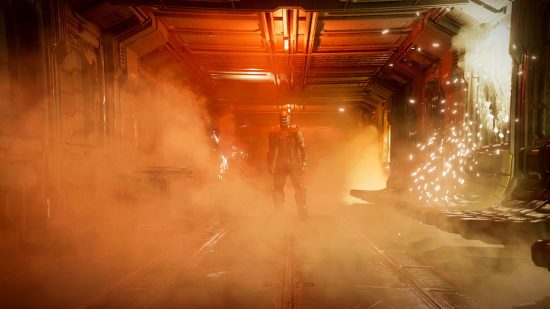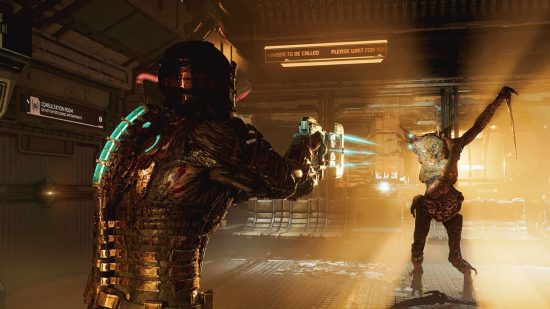The USG Ishimura is a haunted place. The halls of the planet cracker mining ship echo with the sounds of the dead, monsters crawling through vents, and the heavy-set footsteps of an engineer having the worst day of his life. Whispers penetrate his helmet and melodic machinery whirrs in the distance, until it all comes rushing in and the sound becomes too unbearable to take, and that’s when the enemy strikes. This is what Dead Space is, and what makes a good horror game truly special.
With the release of Motive’s Dead Space Remake, one of videogames’ most iconic locations has undergone a facelift. The Ishimura is instantly recognisable not just for its visuals, but how it uses sounds – be they instrument or organic- to set a tone like none other, and the remake owes upkeep and revamps to many of these sounds to composer Trevor Gureckis.
“What [original composer Jason Graves] made was a great musical universe for Dead Space,” Gureckis tells PCGamesN. “So we were first really focused on key elements like narrative points and particular cutscenes things that we could expand upon, and the further I got along, the more I started to write more and more music for the bigger scenes.”

Throughout my discussion with Gureckis, it became increasingly apparent that his work was always supposed to mirror that of EA Motive, as the studio had made it clear from the start that it wanted to stay true to the original Dead Space while expanding on it in meaningful ways with mechanics from future installments, more character development, and extra content.
Gureckis played the original Dead Space trilogy as it released, and so working on the series’ revamp is a bit of a dream come true. He said it’s work he’d love to continue, and suggested to us he’d be thrilled to contribute if EA decides to make Dead Space 4. In fact, Motive has said it is “interested” in a Dead Space sequel, so it could happen.
For Gureckis, evolving Dead Space involved creating a musical journey that changes over time, just like the deterioration of Isaac Clarke’s psyche. “I was able to come up with new themes that could be repeated multiple times throughout the game, so that if even subconsciously ‘this feels like I’m in the same room in some sort of dialogue’, musical dialogue, at least.”
In the Dead Space Remake, it can be very difficult to pin down exactly how this subconscious musical effort actually works when you’re playing. You just know from the music and audio design when you’re safe, when the atmosphere is trying to rile you up, and how Isaac is also supposed to be feeling this exact same way, which maps out this unwritten dialogue between you and the character.

Gureckis says that recording with big orchestras and in his personal Brooklyn studio helped him get closer to Isaac and achieve this dialogue. “For me, that was a way to get closer to Isaac and his experience. Which is also the player’s experience, being over Isaac’s shoulder and in the room. You hear this kind of shrieking violin going up and down and all that kind of stuff and it supposed to sound like different pieces of metal,” Gureckis tells PCGamesN.
Gureckis isn’t directly responsible for implementing his soundtrack into Dead Space, he instead gave his work to the audio team who could then use the full tracks or isolated elements from each where they felt each piece worked the best. Gureckis says all of his pieces are “big and dense”, which plays well when they’re broken down in the game.
“I did a whole Shepard tone piece with the orchestra that we recorded in Nashville, and we had the strings doing the piece for like, two minutes or something like that,” Gureckis explains. “We wanted to give the audio team just assets and tools and for them to get into how they wanted to use it in the game.”
I find the Shepard tone particularly interesting in this instance because it exemplifies how music and sounds are so integral to horror, and to the Dead Space Remake especially. The auditory illusion sounds like its pitch is constantly getting higher or lower, which creates an odd feeling where whenever you stop actively listening, it almost sounds like it resets. This type of technique is excellent in a game like Dead Space because it can end up confusing and alienating you at key moments. If successful, it shows that Gureckis’ work has been done, and done well.
For more, check out our guides on all the Dead Space weapon upgrade locations and all the Dead Space node locations too, as we’ve got answers to all of your questions related to exploring the Ishimura.
Dead Space interview: designing the USG Ishimura’s sound of silence
Source: Maharot News

No comments:
Post a Comment